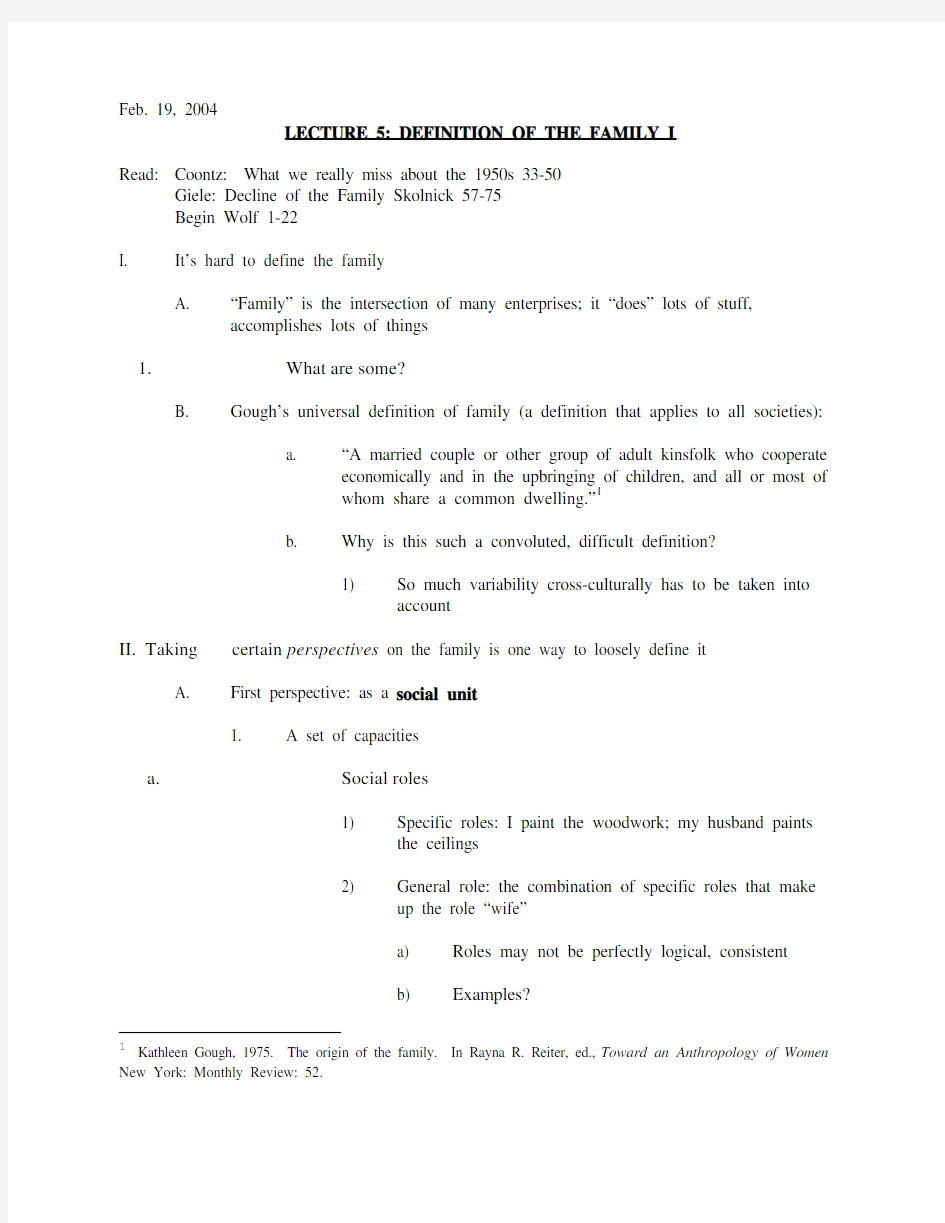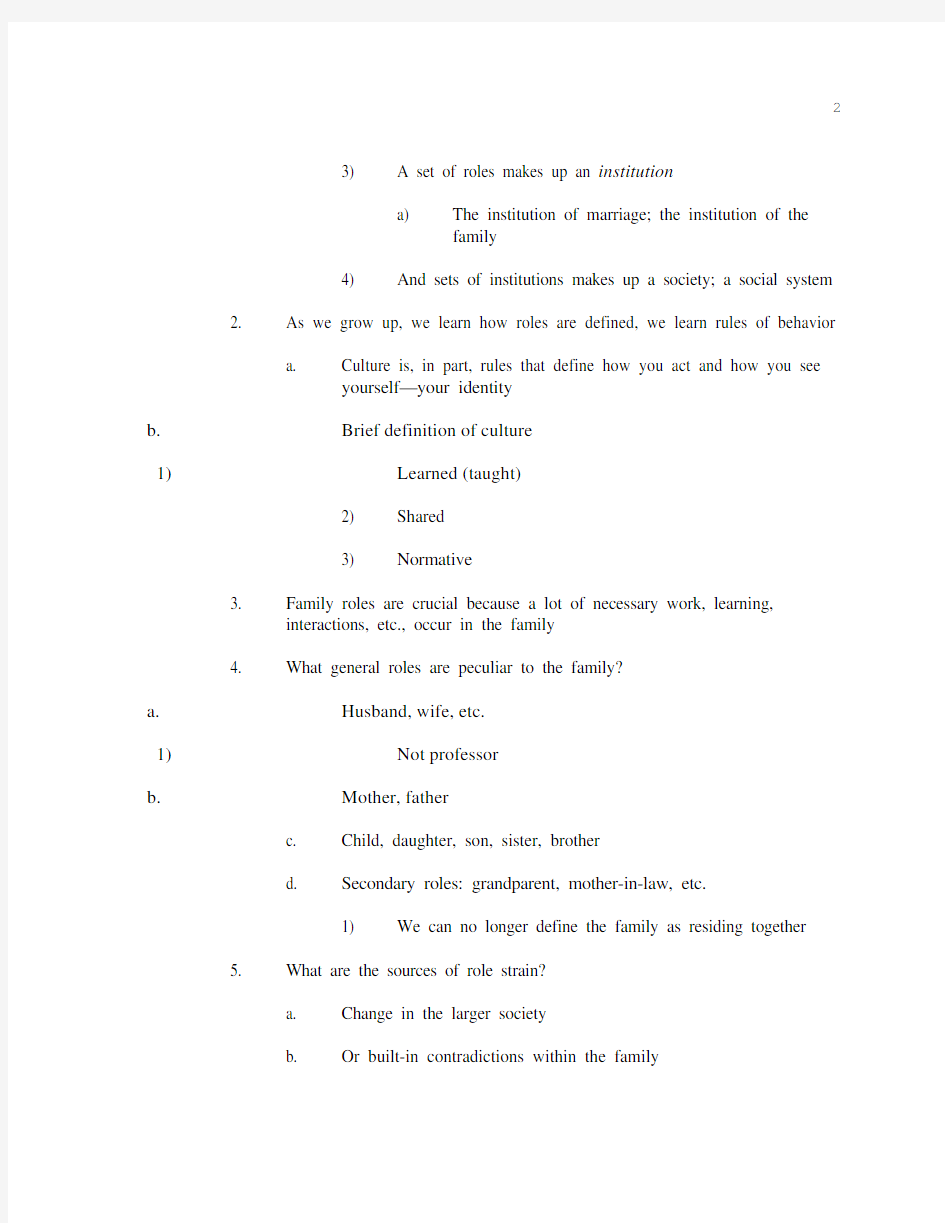MIT-SCIENCE-Lectures-defoffamily


Feb. 19, 2004
LECTURE 5: DEFINITION OF THE FAMILY I
Read: Coontz: What we really miss about the 1950s 33-50
Giele: Decline of the Family Skolnick 57-75
Begin Wolf 1-22
I. It’s hard to define the family
A. “Family” is the intersection of many enterprises; it “does” lots of stuff,
accomplishes lots of things
some?
are
1. What
B. Gough’s universal definition of family (a definition that applies to all societies):
a. “A married couple or other group of adult kinsfolk who cooperate
economically and in the upbringing of children, and all or most of
whom share a common dwelling.”1
b. Why is this such a convoluted, difficult definition?
1) So much variability cross-culturally has to be taken into
account
perspectives on the family is one way to loosely define it
certain
II. Taking
A. First perspective: as a social unit
1. A set of capacities
roles
a. Social
1) Specific roles: I paint the woodwork; my husband paints
the ceilings
2) General role: the combination of specific roles that make
up the role “wife”
a) Roles may not be perfectly logical, consistent
b) Examples?
1Kathleen Gough, 1975. The origin of the family. In Rayna R. Reiter, ed., Toward an Anthropology of Women. New York: Monthly Review: 52.
3) A set of roles makes up an institution
a) The institution of marriage; the institution of the
family
4) And sets of institutions makes up a society; a social system
2. As we grow up, we learn how roles are defined, we learn rules of behavior
a. Culture is, in part, rules that define how you act and how you see
yourself—your identity
culture
of
b. Brief
definition
(taught)
1) Learned
2) Shared
3) Normative
3. Family roles are crucial because a lot of necessary work, learning,
interactions, etc., occur in the family
4. What general roles are peculiar to the family?
etc.
wife,
a. Husband,
professor
1) Not
father
b. Mother,
c. Child, daughter, son, sister, brother
d. Secondary roles: grandparent, mother-in-law, etc.
1) We can no longer define the family as residing together
5. What are the sources of role strain?
a. Change in the larger society
b. Or built-in contradictions within the family
c. Example: ideas of fairness in modern mainstream American
families
good
grades?
paid
for
1) Getting
a) Is this fair? Doesn’t it make siblings compete?
And feel resentful when it doesn’t seem fair?
b) A student once said this practice was stopped in her
family because of a younger mentally retarded
sibling
c) The new arrangement was that the whole family
went out to dinner at end of school year, “job well
done”
2) That fairness ought to be gender-blind is increasingly
subscribed to
a) Daughters increasingly get as much support to go to
college as sons
b) Examples of shifts? Of areas where fairness is still
not gender-blind?
6. Another question related to stresses and strains: is there a lack of fit
between the norms in the family and elsewhere?
contradictions?
a. Outright
1) For example, payment for work done versus allowance,
versus birthday gifts
2) What is the distinction? How do family roles and values
differ from roles in contexts where work is paid for?
b. Housework: how is it like work done on the outside and how not?
stresses
there
of
1) Lots
B. Second perspective: Family as a kinship unit
1. Where roles are defined by reference to kinship (descent or marriage)
a. What is kinship? The answer is not immediately obvious
1) Cultures vary in terms of how they define who is kin to
whom
lineality
of
types
a) E.g.
allow
doesn’t
b) Cousin
marriage—Catholic
Church
first cousin marriages; other societies do, even say
that marriage between certain types of first cousins
is the ideal
b. What are the basic axes of kinship for us?
blood
1) By
mother,
sibling
a) Father,
related
chromosomes,
by
are
(1)
We
believe
we
etc.
(2) We’re related to our parents, but not to our
spouses
things
differently
very
see
cultures
(3)
Other
ceremony?
brother”
a
“blood
b) What’s
2) By law
a) Marriage, a legal arrangement has to happen
b) Even marriages “made in heaven” have to be made
on earth, too
this
important?
is
Why
(1)
opera
the
“Madama
(a)
The
theme
of
Butterfly”
was
a
real
marriage;
it
thought
(b)
She
he was ethnocentric and racist, knew
from the beginning he’d choose a
“proper” (white) wife
and
his (c)
when
he
kills
herself
She
new wife come to claim her son
3) Legitimacy is not so important now
illegitimate—intentionally
famous
some
have
a) We
so—births in this country
b) But it used to be very important
child”
“Love
c) The
Supremes’
(1) Listen to the song’s lyrics to understand the
connections often made between
illegitimacy and other negative factors
c. Features of marriage found widely?
kinship
groups
2
1) Joins
duties
and
rights
2) Allocates
and
wife
husband
roles
of
a) The
activity
3) Regulates
sexual
offspring
4) Legitimates
a) Who is to be considered the father? In our society
traditionally, no marriage, no father, in some
respects
b) The Skolnick introduction says this might not be
true anymore
“natural”
child?
is
c) What
a
d) For us, sexual intercourse is the prime symbol of
marriage
e) Why we giggle at polygyny, at the idea of woman-
woman marriage in parts of E. Africa
not lesbian relationships
(1)
are
these
But
f) And why marrying a ghost or stick seems so weird
g) Because for us, blood is a matter of birth, birth a
matter of procreation, procreation a matter of sexual
intercourse
at
exceptions:
look
to
helpful
h) It’s
Christ
Jesus
(1)
(2) Different for Catholics (Mary is seen to have
remained a virgin all her life—and she came
to be seen as immaculately conceived)
(3) Pay attention to the lyrics of “The Cherry
Tree Carol” next Christmas
soap
a
opera
bit
A
(a)
of
who
the
he
is
tells
(b)
Joseph
Mary,
“let
father of your child get cherries for
you”
the
from
womb—“bend
spoke
(c)
Jesus
down, that my mother might have
some cherries”
between
power
father
A
of
(d)
contest
and son, which the son wins, and,
more indirectly, between social
father and biological father (God)
(e) Note that Mary doesn’t have the
power to make the cherry tree bend
down—she has to get them from a
male—Joseph, and then Jesus
2. Types of families, according to kinship relations
a. Nuclear
b. Polygamous
c. Extended
family
family
d. Matrifocal
family
e. Stem
3. So, the right questions to ask are:
in that society?
system
kinship
a. What’s
the
marriage
in that society?
b. What’s
c. What things constrain or strain these?
C. Third perspective: family as process
1. Family as a phase in the process of reproduction
phase
a. Relatively
long
2. How enduring is it?
3. What causes its consolidation and fragmentation?
III. There are 3 other possible perspectives:
A. Family as an economic unit
consumption
1. Production,
exchange,
2. How is family a self-contained economic unit? How not?
B. Family as a ritual unit
1. A site where rituals get enacted: e.g., exchange of gifts at Christmas
Thanksgiving
at
a. Eating
2. What are the values and beliefs here?
3. Family as a medium for symbolic communication
a. As a model for other areas of life
b. A miniature version of how they ought to be elsewhere
“family”
of
metaphors?
Examples
(1)
C. Family as a residential unit
1. Household
2. Who eats together, sleeps under the same roof?
a. Our assumption is that the co-residers are the nuclear family
3. And, what are the constraints and strains?
Note: These perspectives aren’t mutually exclusive
